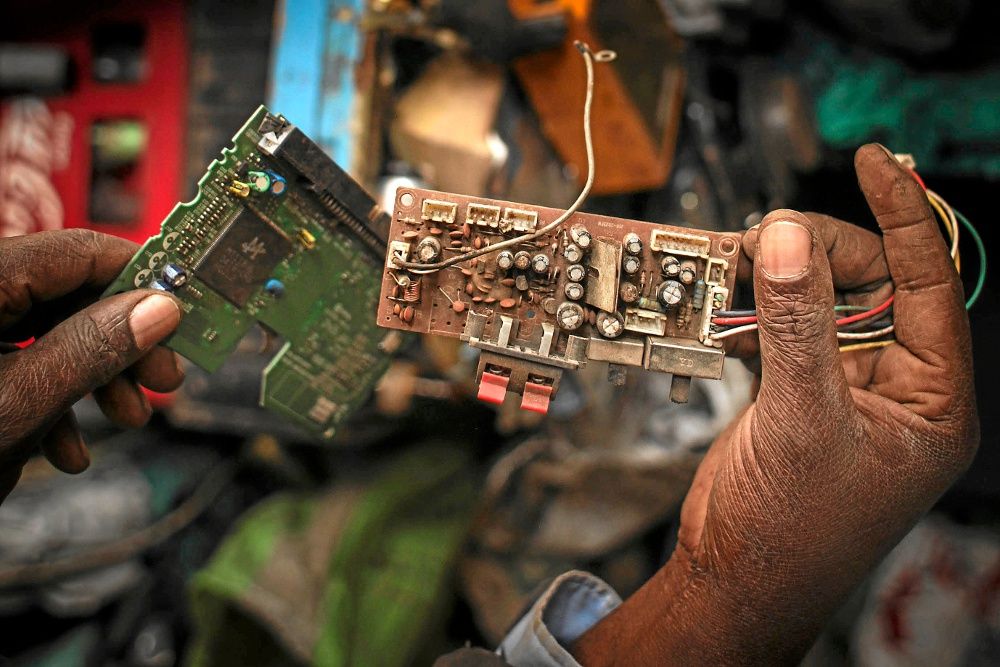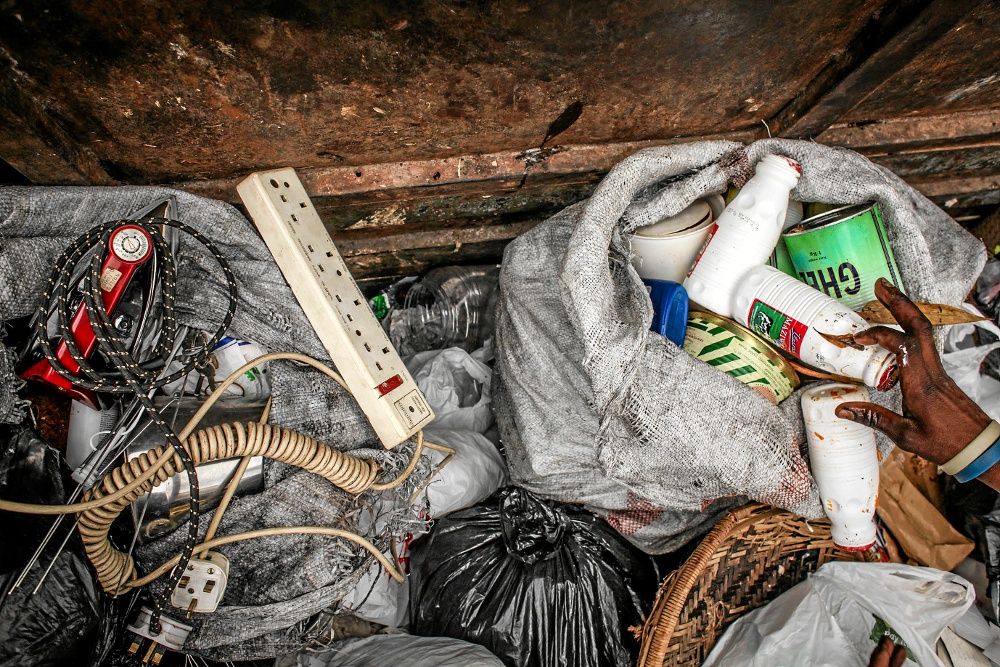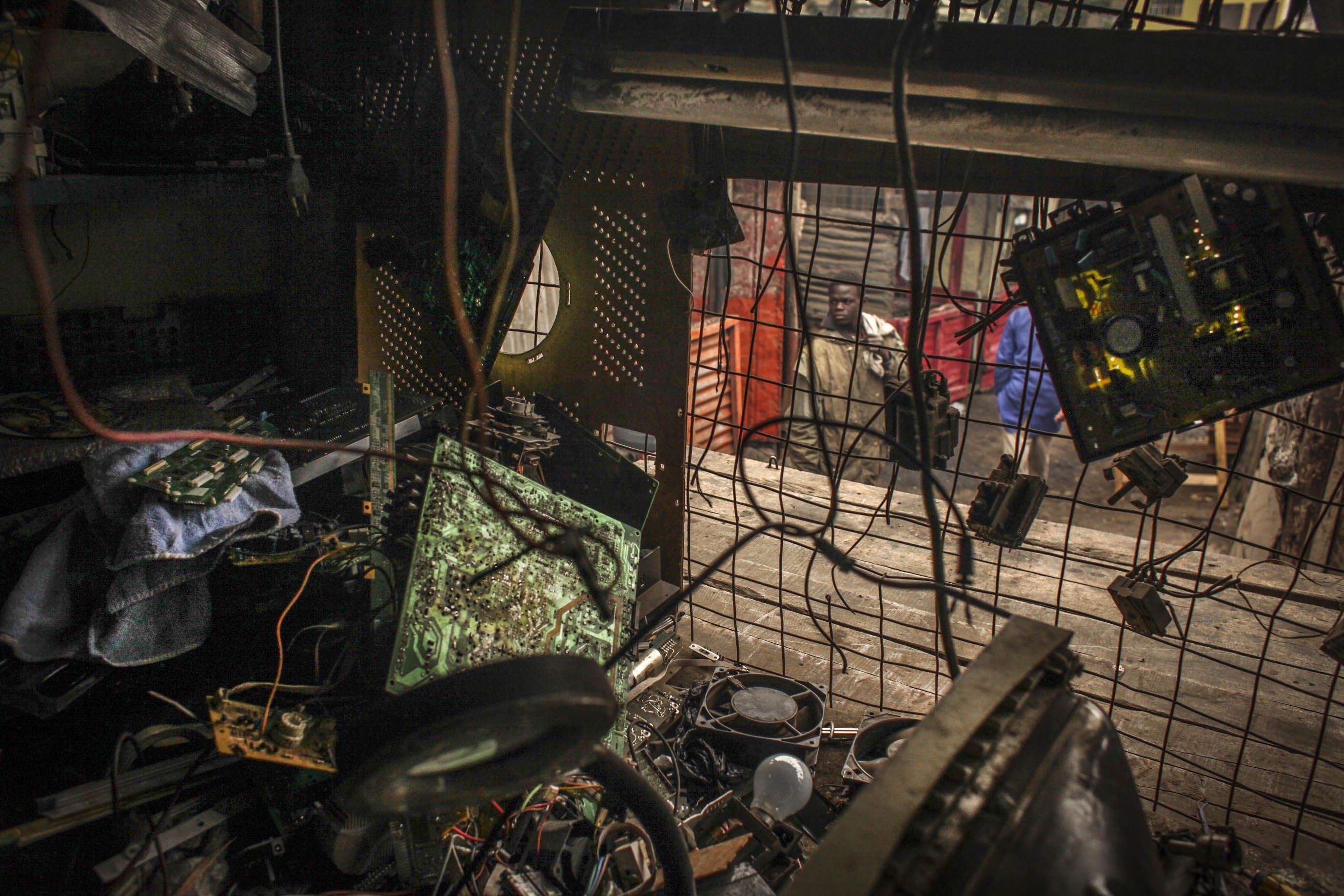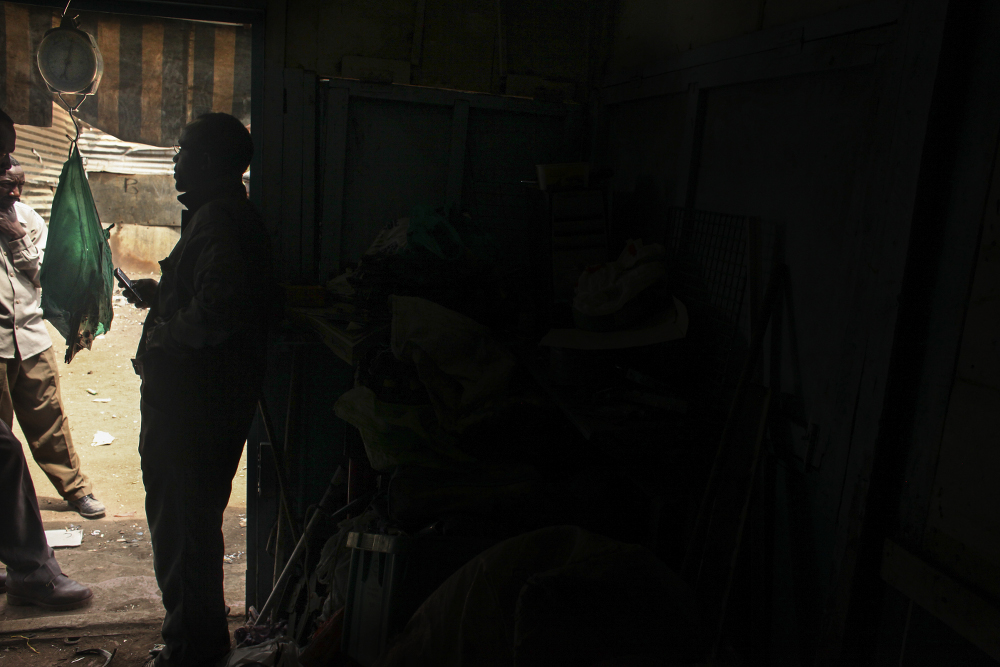How African artist turns electronic waste to works of art
A cloud rises above the hills of Dandora, Nairobi's largest rubbish dump. The hills are the result of decades of the city's trash, piled up endlessly every day, truck by truck. The cloud is made up of smoke from burning plastic, other fumes and slowly circling birds on the lookout for tasty morsels.
An estimated 6 000 people climb the municipal dump site every day in search for sellable items. The scavengers consist mostly of women, old men and children. The younger men in the recycling business tend to serve on one of many informal rubbish trucks, collecting waste from households and establishments in town. Dandora's sorters weave through heavy piles of grey rubbish, sometimes using a tool, but usually their bare hands.
Some of the women have worked on the dump for over 10 years. When they find scrap metal, they sell it by the kilo at designated informal trader points in the local township. Plastic milk wrappers and bags, when washed in the nearby polluted Nairobi River, sell at R2 a kilo and 25 cents a piece, respectively.
But there is one type of waste Dandora workers rarely find anymore: electronic trash. It is unfortunate, they say, because electronic components sell for much more than metal or plastic.
For several years now, electronic equipment seldom reaches the dump, which seems contradictory, given that electronic waste, a category that barely existed 20 years ago, is now Kenya's fastest-growing waste component. But it becomes clearer when one of the women explains that the people who transport the rubbish keep all the valuable items for themselves, including electronic waste.

Electronic waste has become the most valuable of all recyclable trash. (Sam Wolson)
As a country, Kenya has embraced information and communications technology (ICT) – politically, economically and socially. With a mobile phone penetration rate of more than 70%, and a government committed to investing extensively to improve national and international bandwidth and broadband connectivity, Kenya strives to become a "Silicon Savannah" and central technology hub of Africa.
But this huge technological growth does not come without its consequences. E-waste processing – with its associated health and environmental dangers as well as the potential profits from the recycling of valuable metals – has become a growing concern and priority.
As Kenyans buy and dispose of mobile phones, personal computers, radios and tablets, the country has begun to generate more and more e-waste, plus it is on the receiving end of Western e-waste. Dumping of this waste in African countries such as Kenya, often in the form of second-hand electronic goods that are no longer reusable, began as a result of an increased volume of e-waste in Western countries where recycling laws are stricter.
Kenya's informal market manages most of the local and international e-waste, estimated at more than 37 000 tonnes a year. Without registration, authorisation or adequate skills, informal recyclers recover scrap metals and burn or dispose of the remaining parts.
'Ticking bomb'
"It's a time bomb," says Mercy Nderitu, director of the Weee Centre, one of the few Kenyan government-approved e-waste recyclers and the only one licensed to collect, process and ship the waste. "If someone starts doing it who is not considering the environmental and health hazards associated with the handling, it's a ticking bomb."
Modern electronic components contain up to 60 different elements. Many are valuable, others are hazardous and some are both.
According to Nderitu, there is a simple reason for Dandora's lack of electronic waste. In recent years, e-waste has become a topical issue, making people more aware of its inherent value. As a consequence, Kenyans prefer to store electronic waste instead of disposing of it with their general household waste, and those electronic items that are thrown out are sold by go-betweens before they reach the dump site.

Electronic goods that do get thrown out are gathered by middlemen from the rubbish trucks before they reach the dumps. (Sam Wolson)
Nicholas Kimae is one of those many layers of go-betweens. He owns a workshop in Dandora where he collects, stores and sorts waste, including e-waste. He is 50 years old. Below his muted grey and slightly dirty overall, I can see the collar of a clean blue-checked button-up shirt.
With his patient speech and deliberate movements, he has the air of a friendly yet strict teacher. One of his most precious professional possessions is a portable scale that he hangs from the doorframe in his 5m2 workshop.
"When someone wants to sell something to you, it must be the right weight," he explains, as he adjusts his glasses.
Similar to plastic and scrap metal, e-waste is sold by the kilogram, but at much higher prices. The price depends on the complexity and composition of the electronic components. Kimae buys telephone chips at R95 a kilo, but he pays only R18 for computer motherboards and R12 a kilo for DVD motherboards. He sells each kilo for about R6 more, which makes up his profit margin.
Kimae's price is determined by the price his buyers, whom he carefully refers to as the "gentlemen of Ngara market", are willing to pay.
Competitive business
One of his buyers, a Malaysian man, agrees to a brief conversation, if I do not identify him – suspicious that any foreigner, such as me, could easily use the information against him to open her own, competitive e-waste business.
He smokes ceaselessly and paces the length of his workshop, which is filled with huge bags of electronic parts. His attitude does not change, even after I assure him that I have no interest in joining his trade. His employees, several young Kenyan men, soon politely ask me to leave. Other buyers, including two Lithuanian men, decline a meeting.
According to Kimae, the price paid for e-waste depends on the material. Electronic items such as mobile phones and laptops contain small quantities of precious metals, including gold, silver, platinum and palladium. Scarce metals such as indium and gallium are more common in newer devices such as mobile phones with touch screens and tablets.
He has learned that integrated circuits, used in almost all electronic goods, are the most valuable parts. These are exported to foreign countries such as China for further recycling as Kenya does not have the necessary machinery to dismantle and reuse them.
Kimae probably has better knowledge about e-waste than his fellow collectors and sorters, because he holds degrees in communications, marketing and business management.

Items ranging from old television sets to cellphones await e-waste buyers at an informal market in Nairobi (Sam Wolson)
After 18 years of working for Telecom Kenya, he was laid off in 2007 and has since been unable to find other formal employment, which is why he joined the estimated 80% of Kenya's working population that is employed in the informal sector.
Before selling the motherboards, Kimae removes the aluminium, copper, batteries and plastic. He recycles the metals but burns the plastic and batteries. He points to a small fireplace several metres away.
Kimae's workshop is located in the heart of Dandora township, and is surrounded by playing children and shops offering sodas, fruits and crisps. Whenever the children come too close, Kimae shoos them away with a large stick. They quickly disperse in all directions, giggling and pointing at him.
From experience, they have learned that he would never strike them. He wants to protect them from the waste and the smoke. Kimae knows that the smoke is dangerous and that chest problems are alarmingly common in Dandora. But he does not see any other choice.
"Which one is better?" he asks. "You die of smoke or hunger?"
Lethal toxins
The hazardous materials in electronic goods include lethal toxins such as lead, cadmium, beryllium and brominate flame retardants. Although few directed studies have been undertaken, chemical exposure to e-waste is associated with cancer, cardiovascular disease, fetal loss, neurobehavioural disturbances and genotoxicity.
Historically, Kenya's e-waste industry has been largely uncontrolled and even the government's recent regulatory efforts are fragmented. They range from a clause in the 2006 Kenyan ICT policy and the Communications Commission of Kenya to a tentative verification programme at the Kenya Bureau of Standards and recommendation-based e-waste guidelines, published by the National Environment Management Authority (Nema) in 2011. But a law that actively regulates and enforces e-waste industry standards did not exist – until now.
Because of the near ubiquity of everyday technology – from the increasing cellphone penetration rate to the national shift from analogue to digital TV – the Kenyan government decided to get the ball rolling.
"People keep on asking us about what to do with e-waste and, as an authority, we think it is time for such a regulation," says Immaculate Simiyu, senior compliance and enforcement officer at Nema.
The regulation could indeed be a reaction to rising demand, but it could also be a necessity. As a signatory of two international agreements to control and ban hazardous wastes – the Basel Convention on the Control of Transboundary Movements of Hazardous Wastes and the Bamako Convention on the Ban of the Import into Africa and the Control of Transboundary Movement and Management of Hazardous Wastes within Africa – the Kenyan government might no longer have a choice but to articulate one coherent national policy.
Focus on e-waste
The newly proposed legislation, the Environmental Management and Co-ordination of E-Waste Regulation, will focus heavily on how e-waste is reused, recycled and recovered – in that order.
"Before even breaking it, they must try as much as possible to refurbish," Simiyu says. Only once every other option is explored can the equipment be broken down.
According to Simiyu's colleague, Samuel Munene, who acts as Nema's principle compliance and enforcement officer, components that can be recycled inland – mostly plastic and metals – go through local recyclers. Those that cannot – circuit boards, cathode ray tubes from television sets and computer monitors – are exported to the United Kingdom and Germany, to be reused.
Another main component of the legislation is the import process. Any interested party introducing electronic equipment into the Kenyan market will have to register with the authority and prove that they have found a recycler for the eventual disposal of their products.
As of August last year, Nema had licensed three recyclers, but Simiyu and Munene are optimistic that the number will increase once everyone knows "what the regulation is all about".

A collector weighing e-waste. (Sam Wolson)
But so far the regulation does not include information on the actual technical recycling process itself. Nor does it outline a strategy to involve the expansive informal sector. Munene acknowledges that many Kenyans' livelihoods depend on the informal e-waste recycling business. "We don't want to disrupt that; we want them to be formal," he insists. But how exactly this formalisation will occur remains unclear.
Possibly the biggest challenge the Kenyan government faces in regulating e-waste is ambiguity. Similar to other mostly informal industries, nobody knows just how large the benefits or costs really are or could be. Reliable data simply does not exist. The United Nations Environment Programme published the only, and most recent, e-waste estimates in 2009, the same data that is now used by the Kenyan government.
Nema and UN officials agree that the solution lies in the power of incentives. Incentives for informal collectors to bring their goods to registered recycling services and incentives for consumers to part with the electronic goods they no longer want – and that are often hoarded at home – in exchange for something.
The government-registered recycler, the Weee Centre, has already pushed in this direction, launching a campaign to collect e-waste from consumers in exchange for marketed merchandise such as T-shirts and umbrellas.
But so far similar incentives directed at informal e-waste workers have been lacking.
Back at Kimae's workshop in Dandora, I ask him whether he will register his business and stop burning toxic materials under the new law. "It's all about money," he replies, without hesitation, leaning against the sheet-metal shack that is his workshop. "Give me money today and tomorrow I'll be doing it bigger and better." – Additional reporting by Sam Wolson and James Kariuki